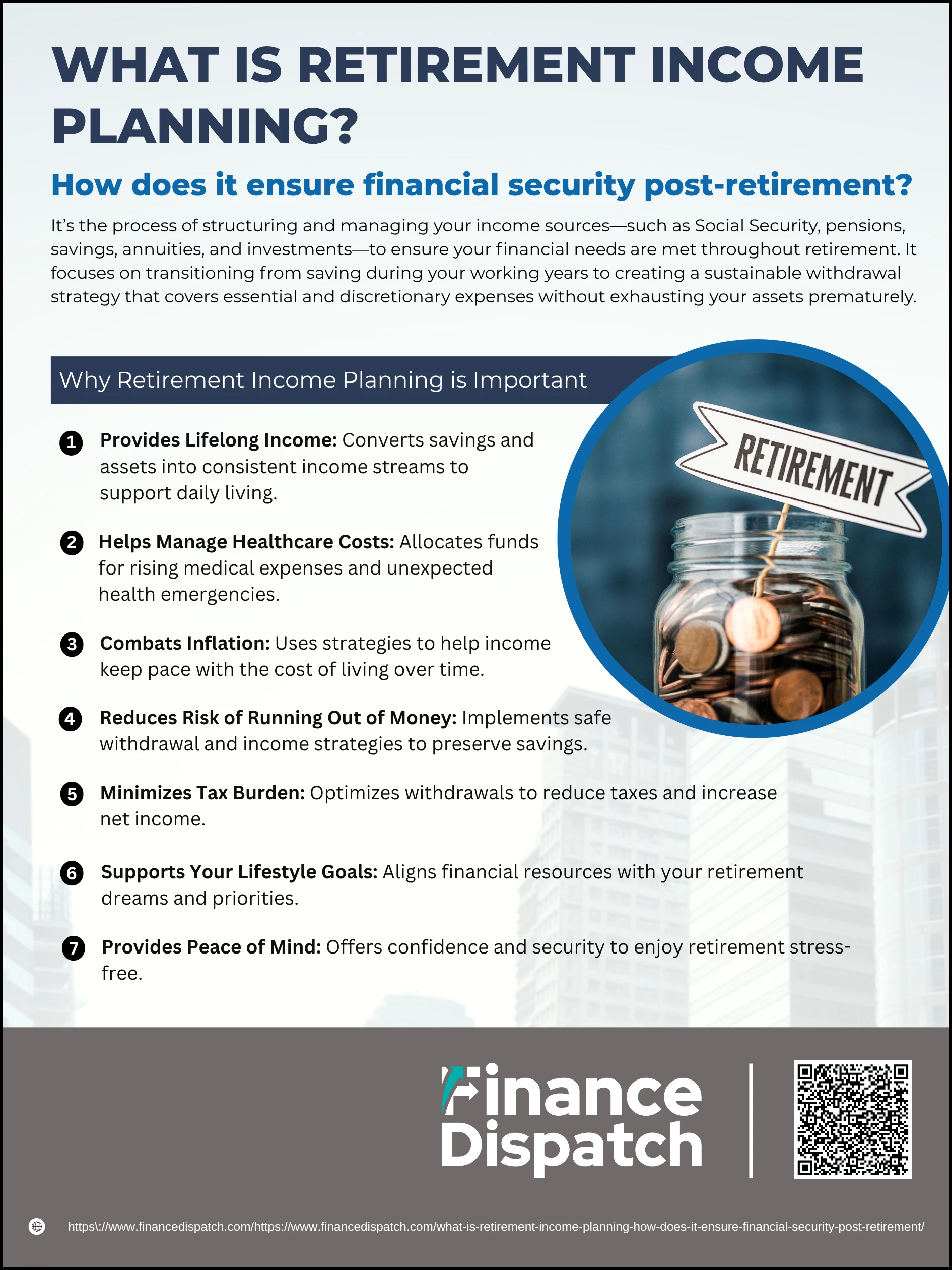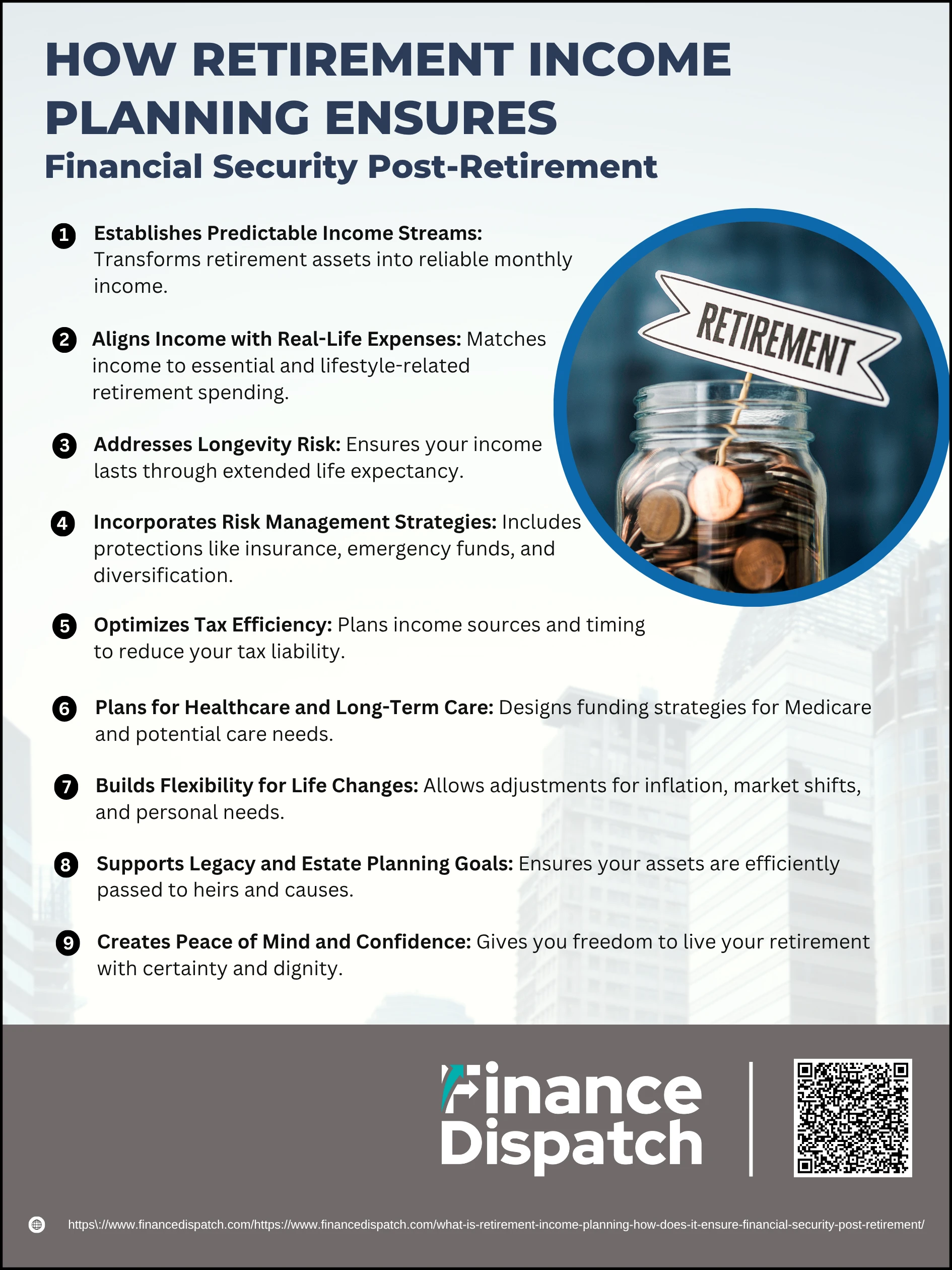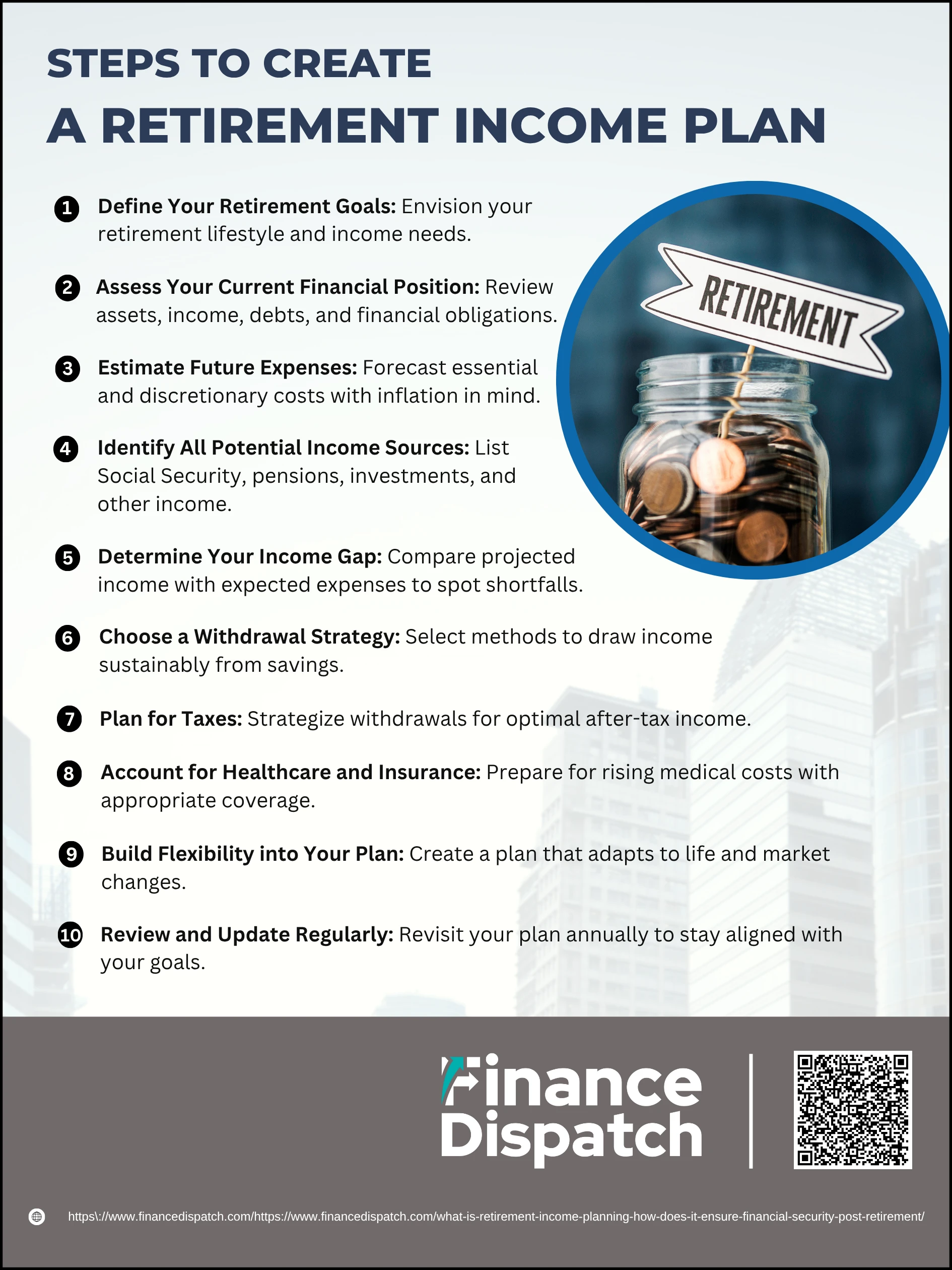Retirement marks the beginning of a new chapter — one where steady paychecks stop, but your financial responsibilities continue. That’s where retirement income planning comes in. It’s more than just saving for the future; it’s about creating a clear strategy to convert your savings, benefits, and investments into a reliable income stream that lasts throughout your retirement years. Without proper planning, you risk outliving your money or sacrificing your lifestyle. By proactively preparing, you can ensure financial security, protect against unexpected expenses, and enjoy peace of mind during your golden years. This article explores what retirement income planning involves and how it helps safeguard your financial well-being long after you’ve left the workforce.
What is Retirement Income Planning?
Retirement income planning is the process of organizing your financial resources to ensure a steady and sustainable flow of income after you stop working. Unlike general retirement saving, which focuses on accumulating wealth during your working years, retirement income planning shifts the focus to preserving and strategically withdrawing that wealth to support your lifestyle in retirement. It involves estimating future expenses, identifying income sources like Social Security, pensions, 401(k)s, IRAs, and investments, and creating a withdrawal strategy that balances income needs, tax efficiency, and longevity risk. The ultimate goal is to make sure your money lasts as long as you do—allowing you to enjoy retirement with confidence and financial stability.
 Why Retirement Income Planning is Important
Why Retirement Income Planning is Important
Retirement is meant to be a time of freedom and fulfillment — not financial uncertainty. Yet, many retirees face the risk of outliving their savings, unexpected medical costs, and rising living expenses. That’s where retirement income planning becomes essential. It goes beyond simply saving money; it’s about building a sustainable income strategy that supports your lifestyle, adapts to economic changes, and secures your financial future. Here’s why retirement income planning is so important:
1. Provides Lifelong Income
A core goal of retirement income planning is to ensure that you have consistent income for the rest of your life. This involves converting savings and assets into reliable streams of money — such as through Social Security, annuities, or systematic withdrawals — that can replace your former salary and support your daily needs.
2. Helps Manage Healthcare Costs
Medical expenses tend to rise as we age. Planning ahead allows you to allocate funds for Medicare premiums, supplemental insurance, long-term care, and unexpected health emergencies. Without this, healthcare can quickly become a financial burden in retirement.
3. Combats Inflation
Inflation slowly erodes the purchasing power of your money. Retirement income planning accounts for this by including investments and strategies that help your income grow over time or adjust to rising costs, ensuring your money retains its value across decades.
4. Reduces Risk of Running Out of Money
One of the biggest fears in retirement is outliving your savings. Income planning helps you avoid this by setting safe withdrawal rates, balancing investment risk, and incorporating guaranteed income products that provide financial stability no matter how long you live.
5. Minimizes Tax Burden
Not all retirement income is taxed the same way. A well-structured income plan considers when and how to draw from taxable, tax-deferred, and tax-free accounts to reduce your overall tax liability, allowing you to keep more of what you’ve saved.
6. Supports Your Lifestyle Goals
Whether you want to travel the world, pursue hobbies, or help your grandchildren with college, retirement income planning allows you to align your financial resources with your personal goals — without jeopardizing your ability to cover essential expenses.
7. Provides Peace of Mind
Perhaps the most valuable benefit of retirement income planning is the peace of mind it offers. Knowing that you have a plan in place to sustain your lifestyle, handle emergencies, and adapt to change reduces stress and allows you to truly enjoy your retirement years.
 How Retirement Income Planning Ensures Financial Security Post-Retirement
How Retirement Income Planning Ensures Financial Security Post-Retirement
When the paychecks stop, the expenses don’t. Retirement may free you from the 9-to-5, but it also introduces new financial challenges that, without careful planning, can turn your golden years into a time of stress and uncertainty. Retirement income planning helps you transition smoothly from earning a regular salary to relying on your savings, benefits, and investments. It’s about creating a structured plan that not only provides income but ensures that income is sustainable, tax-efficient, and aligned with your lifestyle. Here’s how this planning ensures financial security after you retire:
1. Establishes Predictable Income Streams
Retirement income planning helps you convert your accumulated savings — such as 401(k)s, IRAs, pensions, and annuities — into a reliable and consistent monthly income. This gives you financial predictability and the confidence to meet everyday living expenses like rent, food, and transportation.
2. Aligns Income with Real-Life Expenses
A well-thought-out plan evaluates both your essential (non-negotiable) and discretionary (lifestyle) expenses. Whether it’s covering utility bills or funding hobbies and travel, income planning ensures that your finances match your retirement goals, reducing the risk of overspending or running short.
3. Addresses Longevity Risk
With people living longer than ever, you might spend 25 to 30 years in retirement. Without planning, even large savings can be exhausted. Income planning considers your life expectancy and uses strategies like annuities or safe withdrawal rates (e.g., the 4% rule) to help make sure your money lasts a lifetime.
4. Incorporates Risk Management Strategies
Markets fluctuate, emergencies happen, and health conditions may change. Retirement income planning includes buffers such as emergency funds, diversified investments, insurance (like long-term care and health coverage), and annuities to guard against financial shocks.
5. Optimizes Tax Efficiency
Not all income is taxed the same. With proper planning, you can time withdrawals from traditional accounts (tax-deferred), Roth accounts (tax-free), and taxable investments to minimize your tax burden. This means more money in your pocket — not the IRS’s — each year.
6. Plans for Healthcare and Long-Term Care
Healthcare is often one of the biggest expenses in retirement. A strong plan allocates funds for Medicare premiums, supplemental insurance, co-pays, prescriptions, and possible long-term care needs. It ensures that a health issue doesn’t become a financial crisis.
7. Builds Flexibility for Life Changes
Retirement plans shouldn’t be rigid. A good income strategy allows you to adapt as your needs, priorities, or the economy change. For example, if inflation spikes or a recession hits, you can adjust your spending or change your withdrawal order to preserve capital.
8. Supports Legacy and Estate Planning Goals
Retirement income planning doesn’t stop with your lifetime — it also ensures you can pass on your wealth. Whether through life insurance, charitable giving, or naming beneficiaries in tax-advantaged accounts, your income plan can help protect and transfer your wealth efficiently.
9. Creates Peace of Mind and Confidence
Perhaps most importantly, retirement income planning gives you peace of mind. You no longer have to wonder, “Will I have enough?” You can spend confidently, knowing your plan accounts for income, expenses, risks, and legacy — allowing you to enjoy retirement with freedom and financial dignity.
Key Components of Retirement Income Planning
A successful retirement income plan isn’t built on guesswork — it’s crafted by combining several critical components that work together to support financial stability throughout your retirement years. These components help ensure your income is reliable, sustainable, and aligned with your lifestyle, goals, and risks. From identifying income sources to managing withdrawals and taxes, each element plays a vital role in shaping a secure financial future. The following table outlines the key components of retirement income planning and how each contributes to long-term financial well-being:
| Component | Description | Why It Matters |
| Income Sources | Includes Social Security, pensions, 401(k)s, IRAs, annuities, and investments. | Provides the foundation of your monthly or yearly income after retirement. |
| Expense Estimation | Forecasting essential and discretionary retirement expenses. | Ensures your income covers both needs and lifestyle wants, including healthcare. |
| Withdrawal Strategy | Method of drawing down assets (e.g., 4% rule, buckets, annuities). | Helps make your money last and adapt to market or life changes. |
| Tax Planning | Managing when and how funds are withdrawn to minimize taxes. | Reduces tax burden and helps preserve more of your savings for personal use. |
| Inflation Protection | Investing in assets or strategies that keep pace with inflation. | Maintains your purchasing power over decades of retirement. |
| Healthcare & LTC Planning | Preparing for rising medical and long-term care costs. | Prevents large unexpected health expenses from derailing your retirement income. |
| Investment Strategy | Portfolio management based on risk tolerance and time horizon. | Balances growth and preservation of assets for long-term income support. |
| Emergency Fund | Liquid savings for unforeseen expenses. | Provides flexibility and avoids tapping into long-term investments prematurely. |
| Estate & Legacy Planning | Planning how remaining assets will be distributed after death. | Ensures financial wishes are honored and beneficiaries are cared for efficiently. |
 Steps to Create a Retirement Income Plan
Steps to Create a Retirement Income Plan
Creating a retirement income plan isn’t just about having a pile of savings — it’s about knowing how to turn those savings into a steady, lasting income that supports your lifestyle for decades. A thoughtful plan considers your future goals, expenses, taxes, healthcare, and potential risks. Whether you’re years away from retirement or approaching it soon, following a step-by-step process will help you build a roadmap to financial security. Here are the key steps to create a strong and sustainable retirement income plan:
1. Define Your Retirement Goals
Start by envisioning your ideal retirement. At what age do you want to retire? What kind of lifestyle do you expect — travel, hobbies, volunteering? Your goals will shape how much income you’ll need each year.
2. Assess Your Current Financial Position
Take inventory of your assets, debts, savings, and income sources. Include retirement accounts (401(k), IRA), pensions, investments, real estate, and any expected inheritance. Also, evaluate your monthly expenses and outstanding liabilities.
3. Estimate Future Expenses
Calculate how much money you’ll need annually in retirement. Include essential expenses (housing, food, healthcare) and discretionary ones (travel, leisure). Don’t forget to factor in inflation and potential long-term care costs.
4. Identify All Potential Income Sources
List all income streams you’ll have during retirement, such as Social Security, pension payments, retirement account withdrawals, annuities, dividends, and part-time work. This helps you understand how much income you can rely on.
5. Determine Your Income Gap
Subtract your projected expenses from your total expected income. If there’s a shortfall, you may need to adjust your savings goals, delay retirement, reduce expenses, or consider other income-generating options.
6. Choose a Withdrawal Strategy
Select how you’ll draw from your accounts. Common strategies include the 4% rule, bucket approach, or annuity income. The right method balances income stability with asset longevity.
7. Plan for Taxes
Understand how withdrawals from different accounts (taxable, tax-deferred, Roth) will affect your tax situation. Strategize to minimize taxes and maximize after-tax income over time.
8. Account for Healthcare and Insurance
Include coverage for Medicare, supplemental insurance, and possible long-term care needs. Healthcare is often one of the largest expenses in retirement and needs its own dedicated planning.
9. Build Flexibility into Your Plan
Your needs and the market will change over time. Ensure your plan can adapt to unexpected events, like inflation spikes or market downturns, without jeopardizing your lifestyle.
10. Review and Update Regularly
A retirement income plan isn’t set in stone. Review it annually or whenever there’s a major life or financial change. Adjust your goals, investments, or withdrawal strategy as needed to stay on track.
Common Challenges in Retirement Planning
Planning for retirement can feel overwhelming — and for good reason. While saving money is an important first step, ensuring that those savings last for decades requires careful consideration of many moving parts. From rising healthcare costs to unpredictable market behavior, future retirees face several obstacles that can derail even the most well-intentioned plans. Recognizing these challenges early can help you build a more resilient and flexible retirement strategy. Below are some of the most common hurdles people encounter when planning for retirement:
1. Rising Healthcare Costs
Medical expenses tend to increase with age, and without adequate planning, they can consume a large portion of your retirement income.
2. Longevity Risk
Living longer is a gift — but it also means your savings need to last longer. Underestimating life expectancy can result in running out of money.
3. Inflation
The gradual rise in the cost of living reduces your purchasing power over time, making it essential to plan for inflation-adjusted expenses.
4. Market Volatility
Economic downturns and market crashes can significantly impact your investments and retirement account balances, especially early in retirement.
5. Unrealistic Spending Expectations
Many retirees underestimate how much they will actually spend, especially in the first few years of retirement when travel and leisure are more common.
6. Poor Withdrawal Strategies
Without a structured withdrawal plan, it’s easy to take out too much too soon — or too little and sacrifice your quality of life.
7. Tax Surprises
Not understanding how retirement income is taxed — including Social Security and required minimum distributions — can lead to unexpected tax bills.
8. Lack of Diversified Income Sources
Relying too heavily on a single source like Social Security or a 401(k) can increase vulnerability. Diversification improves income stability.
9. Inadequate Estate Planning
Without clear estate plans and beneficiary designations, your assets may not be distributed according to your wishes and could be subject to unnecessary taxes or probate.
10. Failure to Adjust the Plan Over Time
Life changes, markets shift, and health evolves. Not revisiting and adjusting your plan regularly can leave you unprepared for new realities.
Mistakes to Avoid in Retirement Income Planning
Creating a retirement income plan is one of the most important steps toward securing your financial future — but even the best plans can fall short if they’re built on common mistakes. From misjudging expenses to ignoring tax implications, these errors can drain your savings faster than expected or leave you underprepared for life’s uncertainties. By identifying what to avoid, you can strengthen your strategy and gain greater peace of mind during your retirement years. Below are some of the most frequent mistakes people make when planning their retirement income:
1. Underestimating Retirement Expenses
Many people assume their expenses will decrease in retirement, but healthcare, travel, and lifestyle choices can often push costs higher than anticipated.
2. Failing to Plan for Longevity
Not accounting for the possibility of living 25–30 years in retirement increases the risk of outliving your money.
3. Withdrawing Too Much Too Soon
Taking large withdrawals early in retirement can deplete your savings faster, especially if the market takes a downturn.
4. Over-Reliance on Social Security
Counting on Social Security as your main income source may not be enough to maintain your desired lifestyle, especially with rising living costs.
5. Ignoring Tax Implications
Not understanding how different income sources are taxed can lead to costly surprises and reduce your spendable income.
6. Lack of Diversification
Putting all your money into one type of investment or income stream increases risk and decreases flexibility.
7. Not Having a Withdrawal Strategy
Random or emotional withdrawals from savings can be inefficient and unsustainable. A structured plan is essential.
8. Neglecting Inflation Protection
If your income doesn’t grow with inflation, your purchasing power will shrink year by year.
9. Overlooking Required Minimum Distributions (RMDs)
Missing RMD deadlines from retirement accounts can result in hefty penalties and tax issues.
10. Failing to Adjust the Plan Over Time
Life changes — and so should your income plan. Not reviewing and revising it regularly can leave you financially exposed.
Conclusion
Retirement income planning is not just a financial task — it’s a lifelong strategy that directly impacts your comfort, security, and peace of mind in your later years. By understanding the key components, recognizing common challenges, and avoiding critical mistakes, you can build a retirement income plan that adapts to life’s uncertainties and ensures your savings work for you. The earlier and more thoughtfully you plan, the more control you’ll have over your financial future. With a well-structured approach, you can transition into retirement with confidence, knowing that your income is sustainable, your risks are managed, and your goals remain within reach.



